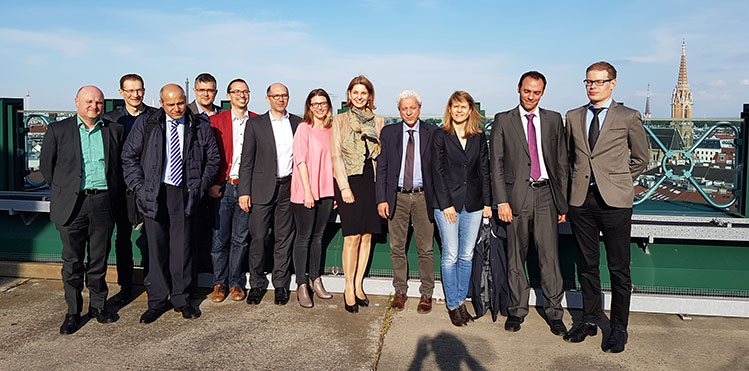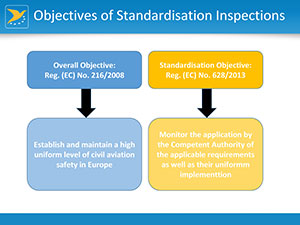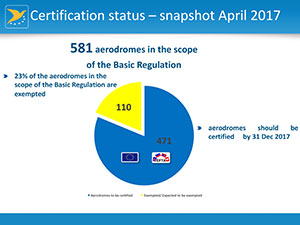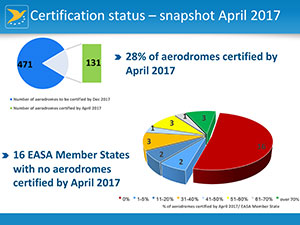On 1st January 2018 National Competent Authorities and Airport Operators will enter into a new phase of the European regulatory environment for aerodromes (ADRs). The date is the milestone for completion of the conversion process of aerodrome licences from a national to the new European certification scheme. Report by ACI EUROPE’s liaison officer to EASA, Ansgar Sickert and Giulio De Crescenzo, EASA Manager Aerodrome Section.
Writing about aerodrome certification for a magazine is challenging – not least because of the amount of things requiring explanation. We begin by explaining the background and rationale for the European aerodrome certification, make the case for those national regulatory bodies who are tasked with overseeing process which started within their jurisdiction – referred to as the National Competent Authorities (CAs). Then there are the aerodromes that have yet to obtain their certificate to carefully review, coordinate and if necessary expedite their certification implementation programme for the 6 months remaining before the deadline of 31st December 2017. As I say, the explanation and the substance of certification is challenging, but stick with me.
As a recent survey of CAs carried out by EASA clearly highlighted, more than two thirds of aerodromes have yet to be certified. However, saying that – most of them are comfortably on their way to meeting the end of year deadline. Nevertheless, given the feedback received by ACI EUROPE from various members, the complications such as a lack of resources either at the airport operator and/or the CA or hitherto unforeseen circumstances, could create significant bottlenecks. What follows in this article really aims to highlight the need for urgent action by everyone involved to make sure that January 1st, 2018 will be a day of quiet celebration, not one of hangovers.
Background on EASA Standardisation
Regulation (EC) No 216/2008 (hereinafter referred to as the ‘Basic Regulation’) places an obligation on the Agency to conduct standardisation inspections in order to monitor the application of the Basic Regulation and its implementing rules (IRs) by national Competent Authorities.
The working methods for carrying out Standardisation activities are described in Regulation (EU) No 628/2013, the so-called Standardisation Regulation which was issued on 28 June 2013 and entered into force on 1 January 2014. Said Regulation introduced a system-oriented Continuous Monitoring Approach (CMA) to standardisation. Under this Regulation, the Agency’s standardisation activities are focused on safety performance and on the efficient use of resources. The objective is to improve the monitoring of the Competent Authorities’ ability to discharge their safety oversight responsibilities without increasing the inspecting burden on them as well as to provide a feedback loop for the Agency’s rulemaking process.

May 2017: EASA Test Inspection team and Austrian Civil Aviation Authority – first steps towards a harmonised European certification scheme.
The means by which these standardisation activities are carried out consists of two parts: a monitoring part, where information is gathered and analysed in order to prioritise inspections, and secondly of an inspection part, where audits are carried out with the aim of directly verifying the application of the rules on the ground. Reports on standardisation activities are provided to the European Commission and to the Member State concerned.
Since the Agency started standardisation activities, the scope of the Basic Regulation has been extended from initial and continuing airworthiness to include aircrew, air operations, ramp inspections, air traffic management and air navigation services and finally, starting from 1st January 2018, Aerodromes.
Standardisation activities are carried out within the Agency’s Flight Standards Directorate and are distributed across the different operational departments, organised by technical domain.
Preparation for Aerodromes Standardisation has begun
At the end of 2015, a full project plan was established by the EASA Aerodromes Section. The overall objective of this project was to plan for all necessary steps required to meet the deadline of January 2018 for the first inspections.

The working methods for carrying out Standardisation activities are described in Regulation (EU) No 628/2013, the so-called Standardisation Regulation which was issued on 28 June 2013 and entered into force on 1 January 2014.
The inclusion of Aerodromes into the existing Standardisation tools and systems has progressed well and both the project plan and the planning remain on track.
One year ago, a network of Sectoral Focal Points for Aerodromes amongst the EASA Member States was established. Next to this, the Competent Authorities also got the possibility to nominate experts to take part in future standardisation inspections, an opportunity most Member States took advantage of, which reflects their positive attitude towards ADR standardisation.
As preparation for the beginning of next year’s post certification standardisation cycle, so called test inspections have already started this year with “trial visit” in three countries that have volunteered to act as test cases. The test inspections are an important tool for learning and sharing experience and expertise for all parties involved. The maturity of the ADR STD system will be assessed.
Coordination with the industry is mainly via, ACI Europe, Europe’s main industry association for airports and aerodromes. To facilitate this, the Aerodrome Section is in the unique situation to be working together with an ACI liaison officer who is located at EASA’s Cologne Headquarter. In addition, there are periodical participations from ACI in EASA meetings and vice versa. This close cooperation greatly promotes not just contacts with the industry but fosters mutual understanding of and swift reactions to critical issues and new developments affecting the industry.
Identified challenges

Total number of ADRs in scope of basic regulation with their certification status.
- There are some important differences when it comes to Aerodromes standardisation compared to the other domains. The Aerodromes field has never been covered by a JAA (Joint Aviation Authority) and there are a large variety of aerodromes with highly individual infrastructures, environments and constraints. Because of this specific background and to allow the necessary flexibility for locally customised compliance, the National Competent Authorities, have a higher degree of discretion in the ADR domain. ADR rules are characterized by a long transition period, many flexibility provisions and an extensive use of soft law.
- The main part of ICAO Annex 14 containing design specifications have been transposed into ADR Certification Specifications (also known as CS) that are non-binding in nature. Competent Authorities may have different flexibility mechanism to assess their final technical decisions in this regard.
 Everything is in place to enable a smooth conversion to aerodrome certificates as per Regulation (EU) No. 139/2014. The only risk from the regulatory point of view are changes to the regulation during the conversion period. Some of these changes are under control by EASA (e.g. new issue of the Certification Specifications driven by changes at ICAO level) with the final aim to minimize the impact on the CAs by loading significant changes in the regulations on them and aerodromes.
Everything is in place to enable a smooth conversion to aerodrome certificates as per Regulation (EU) No. 139/2014. The only risk from the regulatory point of view are changes to the regulation during the conversion period. Some of these changes are under control by EASA (e.g. new issue of the Certification Specifications driven by changes at ICAO level) with the final aim to minimize the impact on the CAs by loading significant changes in the regulations on them and aerodromes.
Certification – Status Update
In 2016, a mid-transition survey was sent out by the Agency to the Competent Authorities of EASA Member States in order to assess the overall current status of the certification process in the Member States. The responses received revealed that there were minor differences between the number of aerodromes in the scope of the Basic Regulation and the number originally collected by the Agency in 2013. On the other hand, it also revealed that a modest number of aerodromes had been certified. However, most States indicated that they had anticipated a long and in-depth preparation period which would culminate in the conversions in the course of this year.
A follow up survey compiled at the end of April 2017 provides the most current picture of the status quo of the certification process. According to the survey, 581 aerodromes are in the scope of the Basic Regulation. With ADR in the scope the Basic Regulation according to Article 4 (3a) refers to:
Aerodromes, including equipment, located in the territory subject to the provisions of the Treaty, open to public use and which serve commercial air transport and where operations using instrument approach or departure procedures are provided, and:
(a) have a paved runway of 800 metres or above; or
(b) exclusively serve helicopters;
110 aerodromes, even if in the scope of the Basic Regulation, are exempted based on the provisions of Art. 4 of the Basic Regulation. Member States may decide to exempt from the provisions of the Regulation an aerodrome which:
— handles no more than 10 000 passengers per year, and
— handles no more than 850 movements related to cargo operations per year.
This means 23% of aerodromes are exempted from the regulation leaving a total of 471 Aerodromes to be certified by their respective Competent Authorities in accordance to the new European requirements. When the survey results were collated in late April only 131 (approx. 28% of ADRs in the scope) of the total had achieved certification. The other 72% or 340 airports and National Competent Authorities have their work cut out to meet the deadline in the remaining 6 months.
From the information received, 15 Member States have already certified at least 1 Aerodrome according to the new rules and 16 Member States had no aerodromes certified by April 2017.
From the above analysis, a first conclusion suggests that, with only about six months from the effective implementation of the new provisions, concerns are justified if nearly ¾ of aerodromes can be certified by the end of the year. While experience gained in other areas suggests that many Competent Authorities accelerate their internal processes towards the approaching deadline, both aerodromes and competent authorities should urgently review or where required establish their implementation programmes.
Both airport operators and National Competent Authorities should consider that the basis for a balanced certification process lies in the respective organisations’ Management System as widely available at ICAO level for all Airports.
The ADR.OR.D.005 “Management system” indicates: “The aerodrome operator shall implement and maintain a management system integrating a Safety Management System”, which must necessarily be balanced and proportionate at the same time. Air traffic growth requires improvements globally. For Member States, however, in order to maintain a high level of safety, additional measures are required. The growing complexity of the system, the growing integration and automation, require a more formal and integrated approach to Safety.
Ultimately, there is a need for a balanced and proportionate approach, which should also be more and more coordinated and harmonized to deal with actual problems faced by Airport Operators and which must always be proportionate and in line with the complexity of the Organization we are dealing with at any given time.
The airport’s complex world certainly needed a more rational approach, without losing sight of the importance of the primary objectives in terms of overall safety safeguards. The European Aerodrome Certification process is one important step on the path to a more uniform and therefore clearer approach to running modern airport infrastructure across the geography of EASA’s member states. As an organisation, EASA strives to work closely with all stakeholders to achieve ever higher levels of safety across Europe and beyond – it is an effort that can only be achieved be connecting with every link in the chain.







